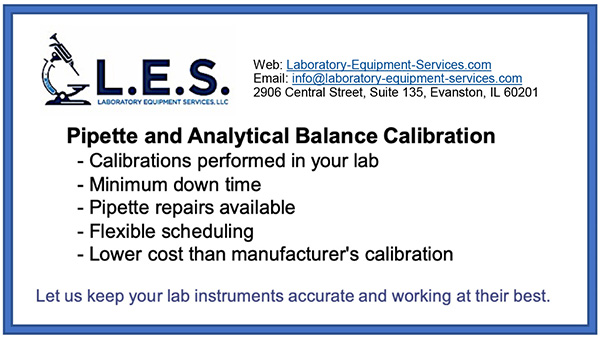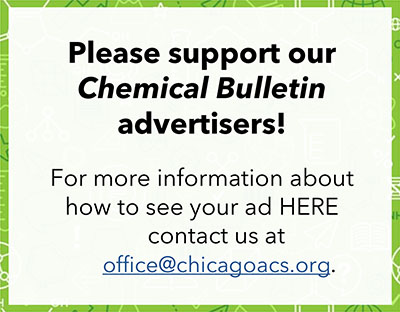In this issue
The March 2022 Chemical Bulletin 
PDF of the Latest Bulletin
https://chicagoacs.org/images/downloads/Chemical_Bulletin/2022_03_chembull.pdf
Next Meeting
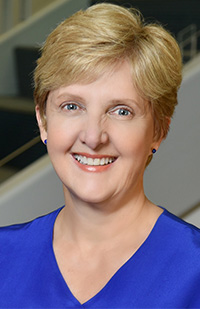
March Monthly Virtual meeting
7:00 - 8:15 PM, Tuesday, March 15
Dr. Bonnie Charpentier
Senior Vice President of Regulatory Affairs
and Compliance at Cytokinetics, Inc.
"Advocacy for Chemistry
and Science Education:
The Power of Local Sections"
ABSTRACT:
Recent years in this country have seen an ever-increasing dismissal and disdain for science and for facts. It is incumbent on us as scientists to step up our advocacy efforts for the good of all, particularly for the education of our population. ACS has a variety of advocacy efforts, many of which are aimed at the national level. However, interactions with legislators often can be more effective at the local level, including with members of Congress, state legislatures, and school boards. Local sections can lead in advocacy for chemistry and science education, particularly when they work together. This presentation will highlight tools available from ACS for effective advocacy, spotlight some successes of local section members, and brainstorm ways to successfully advocate for science and education. There has never been a more important time to reinforce the importance of science to our legislators and to the public.
PROGRAM
REGISTRATION
THIS MEETING IS FREE AND OPEN TO THE PUBLIC VIA ZOOM
Deadline to register is Tuesday, March 15 at 8:00 PM.
or email ([email protected]).
Meet The Speaker
Bonnie Charpentier served as President of the American Chemical Society in 2019. She previously served on the ACS Board of Directors, including as the Chair of the Board. She has served on and chaired a variety of ACS committees and task forces at national levels, as well as being active in local sections, divisions, and regional meetings. In her ACS work, Bonnie has emphasized the importance of communicating the value of chemistry through public outreach and education. She is a strong advocate for ACS programs that increase the effectiveness of ACS's legislative advocacy through member involvement, and for increasing effective collaboration both within ACS and between ACS and other professional societies. Bonnie is currently Senior Vice President of Regulatory Affairs and Compliance at Cytokinetics, Inc., in South San Francisco, California, a company dedicated to the discovery and development of novel small molecule therapeutics that modulate muscle function. She is passionate about the importance of public service, and about turning molecules into medicines.
From the Editor's Desk

The Season of Renewal
As spring approaches, we can look forward to warmer weather and the emergence of new life. We’d like to welcome new members, new volunteers, and new readers. We are ready to escape the chill of winter and to encounter fresh faces and ideas!
The ACS Chicago Section has long-standing relationships with local science industries and businesses. Perusing archived Bulletin issues, we recognize the need to renew those connections after the long “chill” imposed by the pandemic. Local members could benefit from networking opportunities, company tours, and research collaborations. In addition, world-class research is being conducted within the walls of local companies, and we would like to share and magnify those accomplishments. Let’s build new bridges between local chemists and companies!
Our sincere appreciation to Paul Brandt, Mark Cesa, Helen Dickinson, Ken Fivizzani, Josh Kurutz, Sherri Rukes, and Andrea Twiss-Brooks for their contributions to the March 2022 issue of The Chemical Bulletin. Thank you for your dedication and hard work!
- AMBER ARZADON and IRENE CESA
Outreach

2022 STEM Expo
The Chicago ACS participated in the 38th Annual DuPage Area STEM Expo hosted February 21 - 26 by IIT. The expo was a virtual event designed to excite and inform K - 12 students about various STEM fields. Our Outreach Committee prepared videos for activities that kids and their families could do at home. The presentations featured activities about acid-base chemistry, UV light, and polymers. Participants learned about polymers through an activity involving “grow creatures”. Electromagnetic radiation emitted by the sun was demonstrated using UV beads and, in the acid-base presentation, students learned about the pH of household liquids and how to make their own pH paper using common plants such as red cabbage, black tea or butterfly pea flower.
The Chicago ACS also distributed 100 STEM activity bags that contained:
- At-home activities, including materials
- Information about section resources available for K - 12 students and teachers
- Chemists Celebrate Earth Week or National Chemistry Week Magazines published by the ACS
- Safety glasses
Please visit the STEM EXPO website for more information.
- SHERRI RUKES
Letter from the Chair

Chemistry and the Public
Professor Dan Rabinovich from the Joint School of Nanoscience and Nanoengineering in Greensboro NC gave an entertaining presentation at our section’s program meeting in February. An enthusiastic stamp collector and writer about stamps and science, he spoke about how postage stamps illustrate achievements and milestones in chemistry and about how stamps commemorate discoveries of new chemical elements, inventions, and scientific accomplishments in a unique way.
Prof. Rabinovich’s talk is an example of how chemistry can be presented effectively and entertainingly to the public. We all love to learn about science. We are fascinated by photographs from the Hubble Space Telescope of galaxies at the very edge of the observable universe; about how fundamental advances in biology lead to cures for diseases that were once untreatable; and about Nobel Prize winners and their achievements that advance physics, medicine, and chemistry.
One of the most important things that we volunteers in the Chicago Section of the ACS do is to reach out and interact with our members and the public to share our enthusiasm for chemistry and to talk about how chemistry improves people’s lives. Two goals in the ACS’s strategic plan, paraphrased here, specifically target our roles as ambassadors of chemistry:
We provide access to opportunities, resources, skills training, and networks to empower our members to thrive.
We communicate the vital role of chemical professionals and chemistry in addressing the world’s challenges.
How do we in the Chicago Section reach out to our members and the public to do these things?
The work our section’s volunteer experts in chemistry do is coordinated by committees of the Board of Directors. These committees are the focal points for interacting with the public about the value of the chemical sciences and what chemists do.
Our Education and Outreach Division, coordinated by Sherri Rukes, provides resources and assistance to educators and students at all levels, from kindergarten and primary school to high schools, colleges and universities. Through this division, we coordinate community outreach events to promote Earth Day, National Chemistry Week, and other events, and we provide hands-on activities for children and adults at the Illinois State Fair. Through the ACS’s Project SEED program, we provide opportunities for secondary school students from diverse backgrounds to experience chemical research firsthand by working in laboratories under the guidance of expert scientists in our colleges and universities.
The Membership Division, coordinated by Ken Fivizzani, provides services to specific groups within our local chemistry community. Our committees for minority chemists, senior chemists, women chemists, and younger chemists serve the unique needs and interests of these members. Our professional relations committee works with chemists in the section to meet a wide range of career development needs.
The Science Division, coordinated by Mike Koehler, is the home of the awards that the section presents to recognize outstanding service by our volunteers to the section. Additionally, the annual Willard Gibbs Award recognizes exemplary advancements in the field of chemistry nationwide. Our Environmental and Lab Safety Committee provides advice on how to work with chemicals safely and responsibly, and this committee is now encouraging increased awareness of the importance of sustainability.
Our Communications Division, coordinated by Russ Johnson, makes information available to our members and the public about activities in the section through the Chemical Bulletin, the section’s website, and social media postings on Facebook, Instagram, and LinkedIn.
Finally, members of our Administration Division, coordinated by Milt Levenberg, do all the work to organize our monthly program meetings so that they reach the widest possible audiences.
We want to provide the services and information our members and the public need. Let us know what you’d like to see the Chicago Section do for you. I look forward to hearing from you at [email protected].
- MARK CESA
Section News
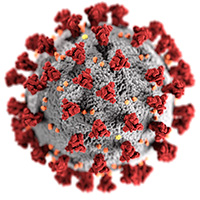
COVID-19 and the Chicago ACS
We are continuing to track the situation in the Chicago area with respect to COVID-19. While the numbers of new cases are still at a high level, there seems to have been a substantial decrease in recent days (see chart.)
We still plan for now to hold our March and April monthly program meetings remotely, but we’re watching closely for an opportunity to begin to hold in-person or hybrid (combined in-person and remote) meetings when conditions enable it. Stay tuned!

COVID-19 cases in Cook County, IL as of February 20, 2022 (source: Google).
Recent Meeting

The World of Chemistry
on Postage Stamps
Though virtual, our monthly meeting on February 17 took us on a fascinating tour of chemistry (and the world) by “virtue” of postage stamps. Dan Rabinovich of the Joint School of Nanoscience and Nanoengineering in North Carolina essentially narrated a history of chemistry ideas using stamps.
From ancient Greek ideas of four elements and the concept of atoms, to the alchemical symbols of Paracelsus, and proceeding to the origins of “modern” chemistry with Boyle, Lavoisier, Dalton, and Priestley, the history of chemistry has been illustrated and celebrated on stamps from nations all across the world.
In addition to major scientific figures from the 19th and 20th centuries, postage stamps have depicted the discovery of elements, the properties of minerals, and the structures of important chemicals such as quinine, Vitamin C, penicillin, and insulin.

Professor Rabinovich highlighted many stamps and first day covers centered on Chicago. The first commemorative U.S. stamp, for example, was issued in 1893 to mark the World Columbian Exposition held in Chicago. One hundred years later, the Chicago-area chemist and inventor Percy Julian was honored on a U.S. stamp celebrating Black History Month.

Visit our archive website at chicagoacs.net to view a recording of this and other past meetings!
Committee Spotlight

Communication is Key
Communicating the value of Chicago ACS membership to our members and the interested public is vital to the section’s success. With 3300+ members across five counties in two states and ranging in age from about 20 to almost 100, the section uses a variety of tools and outlets to reach the intended audiences. This is especially true in this digital age where we are constantly bombarded with information from every device at our fingertips.
The Chicago Section Communications Division, coordinated by Russ Johnson, consists of three committees and nested subcommittees working together to inform members and the public about section events and activities and to encourage their participation. Committees include The Chemical Bulletin, Historian, and Public Relations, with the latter broken down into subcommittees for news media, web, and social media.

The Chemical Bulletin has been the principal tool for communicating with Chicago Section members for more than 100 years, and it has seen many transitions and adaptations in that time. The Bulletin is published as an easily downloadable pdf that is sent via email to all members, posted on the section website, and promoted on social media. Individual articles and announcements are also transmitted in an email newsletter format and appear as anchor links on the website.

The editors are committed to optimizing the design, content, and dissemination of the Bulletin to ensure its continued viability for today’s diverse readership. This includes adding feature content that will appeal to the public, such as Teacher Resources, Safety First, and ChemShorts for Kids. The Bulletin serves as an historical record of section meetings, activities, and governance. One of the main purposes of this Committee Spotlight is to increase transparency and interest in section governance.
Preserving the legacy of the Bulletin and making it accessible to the general public is the responsibility of the Historian Committee. An archived and digitized collection of the Bulletin from 1914 - 1960 and from 1999 onwards is available through the HathiTrust and on the section website. The section is also working to digitize the entire collection.
Social media is an important way to deliver news and information and reach out to followers across the county. The advantages of social media include its immediacy, interactiveness, and ability to engage the public. Sign up today to follow the Chicago Section on Facebook, Instagram, and LinkedIn and to let us know your special interests. You can also write to the chair of the Social Media Subcommittee directly at social - at- chicagoacs.org.

Follow us at:
https://www.instagram.com/ChicagoACS/
https://www.facebook.com/ChicagoACS
https://www.linkedin.com/groups/1854603/
Safety First

Chemical Hazards and the
Effect of Particle Size
Sharing stories is a great way to build an inclusive and respectful culture of safety, and it is at the heart of the Safety First! initiative for the Chicago Section. Storytelling is also an indispensable aid in teaching, learning, and leading. Facts are easier to understand and assimilate when they are grounded in a story. Stories allow people to grasp information in context and can be highly motivational as well. The genesis for this month’s report concerning the effect of particle size on chemical hazards and reactivity was provided by a recent news story about a chemical fire in California.
On January 25, 2022, fire broke out at a farm supply warehouse in Modesto CA storing 900 tons of sulfur. Preliminary reports suggest the fire may have originated from combustible sulfur dust that was ignited by a spark when a worker changed a light bulb.

Industrial colleagues are well acquainted with the management of combustible dust hazards. Others may be thinking “well, thank goodness, I don’t have to worry about that, I mean, really, 900 tons of sulfur!” But particle size matters when it comes to the properties of chemicals, and substances that are considered nonhazardous in “bulk” solid form may pose dangerous health and chemical hazards even for laboratory scale operations when particle sizes are reduced. Granular zinc “dust,” for example, is a common reagent in introductory chemistry labs. It is also highly flammable and may ignite spontaneously in contact with air. Zinc dust is also very reactive with water, acids, and base. Improper disposal of residual zinc dust, especially when wet, can lead to unexpected overnight fires due to continued hydrogen generation.
In addition to metals such as aluminum, magnesium, and zinc, nonhazardous solids such as sugar and starch also have high explosive potential in powdered form. The severity of combustible dust explosions is estimated using the so-called deflagration index, which is abbreviated Kst. The units for Kst are pressure (bar) × meter per second. Based on measured Kst values, combustible dusts are ranked on a scale from 0 to 4. The results depend on particle size; most combustible dusts are in the sub-100 micron (0.1 mm) size range.
The meaning of Kst values is not commonly taught in laboratory safety courses, and most Safety Data Sheets provided for laboratory-use chemicals also do not include these values. The combustible dust or explosion pentagon serves as an extension of the familiar fire triangle to illustrate the dangers of working with finely divided or dispersed powders, especially in closed or confined spaces.

Reactivity and combustion are not the only chemical hazards that depend on particle size. Powders and dusts are typically inhalation hazards as the small particles may irritate the airways and lungs. Breathing small particles may also cause allergic sensitivity and increase the risk of cancer. Many well-known occupational diseases are associated with prolonged exposure to particle dusts. Avoiding exposure to airborne particles via proper use of ventilated enclosures and personal protective equipment is key to minimizing risk.
- IRENE CESA
Do you have an idea for a Safety First topic or presentation? We welcome your ideas and contributions! Please write to [email protected] to share your stories.
Sustainability

Carbon Capture -
Is It Sustainable?
Just as the origins of greenhouse gases that cause climate change are many and varied, the solutions to limit the consequences must also be manifold. Among possible approaches to reducing the amount of carbon dioxide in the atmosphere, the International Panel on Climate Change has acknowledged that removal of carbon dioxide from emission sources and directly from the atmosphere will have a role in reducing CO2 emissions and limiting future temperature increases due to climate change.
A variety of chemical and physical processes and technologies for carbon capture and storage (CCS) have been implemented, including here in Illinois. For me, a child of the space age, the image that comes to mind when I think of carbon capture is Apollo 13. When an explosion crippled the command module, the astronauts aboard the spacecraft were forced to seek refuge in the lunar module or LM. The LM, however, was designed to accommodate only two astronauts, and there were not enough lithium hydroxide canisters in the LM to absorb the CO2 emitted by the respiration of three astronauts. Read the book to learn more!

Modern CCS technologies for post-combustion CO2 removal include amine-based solvent extraction systems where the gas undergoes a reversible reaction with the amine to increase solubility, and “physical” solvents that rely on intermolecular forces to dissolve CO2. In both systems CO2 is removed from the solvent by heating at high temperatures and/or low pressure. The recovered CO2 can then be stored underground or pumped into reservoirs for enhanced oil recovery.
There are two problems with these strategies: heating the solvent to remove CO2 requires energy, which typically generates more CO2, and using it to increase oil recovery perpetuates a reliance on fossil fuels. Despite these potential disadvantages, CCS is becoming a dominant force in large-scale industrial projects.
Alberta, Canada has invested heavily in building CCS infrastructure, which in turn has attracted companies such as Dow and Air Products to invest in net-zero emission refinery complexes in the province. The success of this carbon capture strategy depends on a tax on carbon emissions.
Closer to home, Linde Engineering, in collaboration with the University of Illinois, BASF, and the National Energy Technology Laboratory, is building a pilot plant at a municipal power plant in Springfield IL to test advanced carbon capture technology. The plant will have the capacity to remove 200 metric tons per day of CO2 and is considered a steppingstone to eventual retrofitting of existing power plants. Also in Illinois, Archer Daniels Midland (ADM) announced in January 2022 that it is building a 350-mile pipeline to transport CO2 recovered from its bioethanol plants in Iowa to Decatur IL, where it will be sequestered underground in a porous sandstone formation. The Decatur site has been used and monitored for this purpose since 2014. When completed, the ADM pipeline will have the capacity to transport 12 million tons per year of carbon dioxide.
 Photo Credit: Terry Farmer Photography, C&EN
Photo Credit: Terry Farmer Photography, C&EN
These examples represent technological and engineering solutions to elevated levels of carbon dioxide. Nature has devised its own solutions in the form of plants and trees that are natural CO2 “sinks.” In addition to reducing CO2 levels, reforestation plans can also improve biodiversity and protect against flooding due to climate change. As with so many issues related to sustainability, it is important to utilize all the tools at our disposal.
- IRENE CESA
For a complete account of carbon capture and storage processes, including ways to remove carbon dioxide directly from the atmosphere, see “The life-or-death race to improve carbon capture” in the July 18, 2021 issue of Chemical & Engineering News. There’s even a role for CO2 removal based on reactions with an alkali metal hydroxide! https://cen.acs.org/environment/greenhouse-gases/capture-flue-gas-co2-emissions/99/i26
ACS Resources

Nanotechnology Safety Resources
The Safety First! article on page 6 covered the effect of particle size on chemical hazards and reactivity. In addition to promoting a Safety First! viewpoint in section activities, a second main purpose of the Environmental and Lab Safety Committee is to disseminate safety resources available from the ACS. In early January the ACS Committee on Chemical Safety, together with the Division of Chemical Health and Safety, announced the creation of a new page on its website devoted to nanotechnology safety resources.
The webpage outlines the ACS Guidelines for Safe Handling of Nanomaterials in the Laboratory. The guidelines follow laboratory safety’s organizing principle of RAMP: Recognize hazards, Assess risks, Minimize risks, and Prepare for emergencies. Helpful links are provided. The page summarizes the importance of engineering and administrative controls to help minimize risk when working with engineered nanomaterials, and provides a set of authoritative references on the subject.
Other resources include the archived ACS webinar “Working Safely with Nanomaterials in the Laboratory” and the world-class International Institute for Nanotechnology at Northwestern University, which has a wealth of nanotechnology safety information on its website. Check it out!

Teacher Resources

Taste the Rainbow
If you want to do something special for St. Patrick’s Day in your science classroom, the following activities are favorites with any age group. These activities are just two examples from the catalog of resources the American Association of Chemistry Teachers (AACT) has on its website to help K - 8 teachers demonstrate chemistry concepts AND celebrate holidays.
Middle School
Candy and leaf chromatography activities will help students learn that mixtures are created by the physical combination of two or more substances. Students will also discover that many colors found in nature and in food dyes are actually mixtures of different pigments. In this activity, different color pigments found in leaves or in candy are separated based on differences in their polarity using a technique called chromatography. The term chromatography literally means “color writing,” and this activity can be used at either the start of a unit to engage student interest, or at the end of the unit to explore the properties of mixtures.
Elementary School
In the M&M Solution Lab, students investigate dissolving using different types of colored candy (M&Ms can be replaced with Skittles) and a variety of variables. Students will determine whether dissolving happens faster with or without the assistance of the tongue and teeth. By the end of the activity, students will have gained basic knowledge of how solutions are made, including the terms solute and solvent, and what causes solutes to dissolve faster. How fun is that! You get to experiment, learn chemistry, and have candy.
- SHERRI RUKES
Corrosion - Why Is It Important?
As spring is approaching and the winter salt slowly begins to wash away, this is a good time to teach chemistry students of all ages about corrosion.

Why should students care about corrosion?
Corrosion results from oxidation of a metal. This can be a good thing, as in the controlled reactions that take place in batteries or are used in artwork. Left unchecked, however, corrosion would eventually destroy much of the country’s infrastructure and transportation industry. Corrosion is the all-too common result of electrochemical reactions between building materials and the environment.
Corrosion is a dangerous and costly problem in the U.S. and all over the world. According to NACE (the National Association of Corrosion Engineers), corrosion costs the U.S. about $276 billion dollars a year. Without protection against corrosion, bridges, buildings, and other structures would collapse, pipelines for oil or gas would develop dangerous leaks, medical implants would fail, and planes and trains would suffer catastrophic failure.
The chemistry of corrosion
Corrosion is an oxidation-reduction (redox) reaction. Generally speaking, corrosion happens when most or all of the atoms on the surface of a metal get oxidized. This causes damage to the surface. Metals tend to oxidize and lose their electrons to oxygen and other substances in the environment. When this happens, oxygen atoms are reduced and gain electrons. The reactions result in formation of metal oxides that are thermodynamically more stable than the reactants.
Corrosion activities
As with all chemistry concepts, the best way to learn this topic is to explore the phenomenon in the lab. One traditional activity for this purpose involves adding a silver- and then gold-colored coating to a penny. For a modern twist on this activity, take a look at the NACE lab manual (see reference) which shows how you can apply a zinc coating to a penny using electroplating
Coating a metal by electroplating
The most common types of coatings involve different metals (galvanization) and organic coatings (paint).
One way metal coatings can be applied is by electroplating, in which a thin layer of a less reactive metal is deposited onto an object made of a more reactive metal. The process uses a negative charge and an electrolyte solution containing cations of the less reactive metal. The metal cations are attracted to the negatively charged metal object and are reduced in the process. The result is a thin, relatively inert or unreactive metal coating, such as gold or silver, on the object. A helpful mnemonic device for remembering the components needed for spontaneous redox reactions is ACME, which stands for Anode, Cathode, Metal, and Electrolyte. The NACE lab manual includes a simple, easy and quick experiment to demonstrate electroplating of zinc on a penny.
Lab manual about corrosion
https://nace-foundation.org/wp-content/uploads/2020/04/cKit_BOOKLET_FINAL.pdf
Video about corrosion prevention
https://www.youtube.com/watch?v=bKvroCboUVc&t=1s
- SHERRI RUKES
AACT
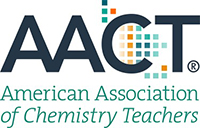
AACT content-writing opportunity
for K-12 teachers!
You are invited to submit a unique lesson plan reflecting the 2022 theme for Chemists Celebrate Earth Week, “The Buzz About Bugs: Insect Chemistry.” Winners will be selected for both the K-8 level and the high school level. Winning teachers will receive $250 and be featured on social media. Learn more and enter today, the deadline is March 14!

ChemShorts for Kids

Fishing for Ice
Why do snow plows put salt on the roads in the wintertime? We’ll do a little experiment to see what’s going on here.
Materials
- Glass
- Ice cubes
- Salt
- String, yarn or thread
- Scissors
- Optional: Food coloring
Be Safe
Food coloring will stain skin and clothes. For best results, work with an adult to supervise and guide you.
Experiment
Cut a piece of string or yarn about 12" long, so that you can place one end in the glass and leave a tail that overhangs the side of the glass. Fill the glass with water and add an ice cube. Notice that the ice cube floats. Place one end of the string on top of the ice cube and leave the other end hanging over the glass. Sprinkle a layer of salt on top of the ice cube and string. Wait for two or three minutes and then carefully lift the string hanging over the edge of the glass. You should be able to lift the ice cube out of the water with the string! If it doesn’t work, try adding more salt or wait a bit longer.

What’s happening?
When water freezes, it goes from the liquid state to the solid state. What we would see if we were the size of atoms or molecules is water molecules moving around really fast in the liquid state. In the solid state, however, the molecules would be organized and almost locked in place. The only motions you would see in the solid state are atoms and molecules rotating and vibrating.
Water freezes at 32 °F or 0 °C. When salt is added to the ice, it lowers the temperature at which the water freezes. This effect is called the “freezing point depression.” So instead of water freezing as it does normally at 32 °F, it might be 26 °F when salt is added. You should have noticed the ice cube start to melt right away. As the ice melts, it must pull energy from its surroundings, making the surroundings colder. This is why your fingers feel cold if you pick up an ice cube. As the “salted” ice cube melts, any water on the string gets colder and refreezes, which allows you to pick up the ice cube with the string frozen on its surface.
Optional
To better see the ice cube beginning to melt as salt is added, drip food coloring on top of the ice. With added color, you should notice water channels forming in the ice as it melts.
Explore more at
https://www.rookieparenting.com/why-does-salt-melt-ice-freezing-point-experiment/
https://www.scientificamerican.com/article/lift-ice-cubes-with-chemistry/
To view more “ChemShorts for Kids” activities, go to:
https://chicagoacs.org/ChemShorts
- PAUL BRANDT
Ice Sports at the Olympics
Did you enjoy watching ice sports at the recent Olympics? These sports employ a special person called the “Ice Master” to make sure that the conditions are optimum for ice skaters to spin and jump, and for speedskaters to glide smoothly at top speed over the ice.

Different ice thicknesses and temperatures are used for different types of rinks, but the most important factor is that the water used to make the ice must be ultra pure. This ensures uniform surfaces for athletes to compete.

Information and Announcements
Project SEED Internships
http://www.acs.org/projectseed
2022 CCEW Illustrated Poem Contest
The Buzz About Bugs:
Insect Chemistry
Puzzle

CRYPTOGRAM
Reprinted from January 1958 issue of The Chemical Bulletin
UHOIYHI RGU OQU
HGQRISXGCU, JZOCQ JM
QRI IWWNXQU NW G WIE
GXHROQIHQU GYS NW
BGYM ENVIXU.
CIEOU GYS XGYSGCC
The answer will be printed in the April 2022 issue of The Chemical Bulletin.
Upcoming Events

UPCOMING EVENTS
|
March 1-2 |
14th Midwest Regional AIChE Conference |
|
March 10 |
Articles due for the April Bulletin issue |
|
March 10 |
Chicago Board of Directors Meeting |
|
March 15 |
March Monthly Virtual Meeting |
|
March 20 - 24 |
ACS Spring 2022 National Meeting; San Diego, CA and Online |
|
April 10 |
Articles due for the May Bulletin issue |
|
April 14 |
Chicago Board of Directors Meeting |
|
April 21 |
April Monthly Virtual Meeting |
|
May 10 |
Articles due for the June Bulletin issue |
|
May 12 |
Chicago Board of Directors Meeting |
|
May 20 |
Willard Gibbs Award Meeting |
Please also refer to the Section’s website chicagoacs.org and social media accounts.
Board & Committee Members

2022 Chicago ACS Section Officers
|
Chair Chair-Elect Past Chair Vice Chair Secretary Treasurer |
Mark Cesa Margaret Schott Sherri Rukes Amber Arzadon Josh Kurutz Michael Morello |
chair-at-chicagoacs.org chair-elect-at-chicagoacs.org past-chair-at-chicagoacs.org vice-chair-at-chicagoacs.org secretary-at-chicagoacs.org treasurer-at-chicagoacs.org |
Masthead
Bulletin Information
March 2022, Vol. 109, No. 3
Published by the Chicago Section of the American Chemical Society
https://chicagoacs.org
Editors: Amber Arzadon and Irene Cesa
editor-at-chicagoacs.org
Digital Editor: Josh Kurutz
Proofreaders: Helen Dickinson and Ken Fivizzani
ACS Chicago Section Office
Address: 1400 Renaissance Drive,
Suite 312
Park Ridge, IL 60068 (847) 391-9091
[email protected]
Social links
Follow ChicagoACS on social media!
Instagram: https://www.instagram.com/ChicagoACS/
Facebook: https://www.facebook.com/ChicagoACS
LinkedIn: https://www.linkedin.com/groups/1854603/


